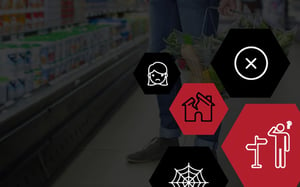The importance of retail branding should never be underestimated. Especially in the retail industry where competition is fierce and differentiation is indispensable. Your customers know what they want to buy, and usually which store to visit. If you want to ensure that the store they visit is yours, you must consider your brand.
Why? The reason is simple: a strong, distinct retail brand means something to your customers. There is also no confusion about the intentions of the brand. As for how you build a strong brand, a good place to start is to cut out on any of the below mistakes.

Mistake 1: Not being known for something
Regardless of what type of retailer you are, you're known for something. It could be that you’re known for selling affordable clothing. Or, you could be known for stocking luxurious clothes of a high quality. Either way, you’ve built up a reputation around your brand to the point that your customers know exactly what they will be getting when they walk into your store.
However, considering the ruthless nature of the retail industry, you can’t expect to remain static and be competitive. Your brand has to change with the times so that it can compete.
That said, in striving to remain competitive, you can push it too far. And that is where mistakes creep in.
Let’s take the retailer who is known for affordable clothing as an example. Their sales figures are down, and have been for three months so they need to do something. However, instead of looking at what products they are stocking or finding out if such a retail branding exercise is worth it, they decide to up their prices. Big mistake.
In upping their prices, they’ve deviated from what their brand have been known for: affordable clothing. And if they continue going down this route, they stand a good chance of losing their brand identity. They’re no longer known for affordable clothing and thus, they’ll also lose business since their customers don’t trust them anymore.
Here are a few examples of retail branding flops, including one about clothing company Fubu, who attempted to start a record label. As stated in that piece, if you’re interested in expanding your brand, first investigate the reasons why.

Mistake 2: Inconsistent shelving
Imagine this: your customer walks into your store and the first shelf they see that stocks your products is metal. Next to it, there’s a wooden shelf with the same product and next to that, there’s a cardboard bin. But none of these shelves were intentionally planned.
While it is an extreme case of what not to do, it illustrates the point that we’re trying to make: inconsistent shelving doesn’t make for a visually appealing store. But it doesn’t stop there.
Inconsistent shelving is also messy, which means that your customers can easily associate this messiness with your store brand. That means that you’ve essentially damaged your brand before your customer even gets to have a close look at your product. Considering your customers usually shop with their eyes first, that is a huge problem.
On the other hand, if your customer walks into your store and sees all of your products presented on the same type of shelving, it provides a consistent look and feel. And isn’t that the point of retail branding? While you need to differentiate yourself from your competition, you also need to be consistent in everything you do.

Mistake 3: Not having a core assortment
The product assortment of your stores is crucial to your overall success. That is because if you pick the wrong products, you won’t sell and you won’t make any money. And we’re not just referring to your general product assortment. Rather, it’s your core assortment.
Otherwise known as a base product range, a core assortment consists of your most popular products and brands. They’re the same across all of your retail stores, regardless of where your stores are located.
For example, you should be able to expect to find Coca-Cola at just about any food retailer, regardless of how different the assortment plan is when compared to another store located elsewhere.
Now imagine that a customer walks into your store and they can’t find it. Considering your customers are expecting you to sell it, they’ll be disappointed. You’ve let them down and your brand has suffered because they’ll also remember not to come back to your store when they need that particular product. If you think you've just lost out on that one sale, you’ll be surprised as buying that one product could lead to buying a few others too.
Considering your core range usually consists of your key value items and your house brands, you face a major problem as you’re losing out on potential sales.
If you have trouble finding out which of your products and brands are the strongest, you can use assortment optimisation software tools.

Mistakes 4: Letting suppliers takeover with shelf talkers
Shelf talkers are an important in-store marketing tool that all stores should seriously consider. That is because when implemented correctly, they act as additional salespeople for your stores. Also, they help to enhance your customer's overall shopping experience.
Of course, mistakes can be made. And one of the biggest errors is to let your suppliers take over with shelf talkers. Why is this a mistake, you ask? In letting your suppliers take over, you’re essentially giving them the power to control how a part of your store looks.
The whole point of shelf talkers is that they are in your store toadd value to your customer’s purchase journey. But that won’t happen if your shelves are overcrowded with them. How are your customers going to navigate through your different categories then? Would they even know where to look for a certain product?
Remember, you own your retail space. That means you have the final say in how your stores are presented. That also includes how many or few shelf talkers are in your stores. That said, you shouldn’t cut your supplier out completely.
If you want to create stylish and effective shelf talkers, and ones that will further your brand, you need to rather focus on a collaboration.

Mistake 5: Inconsistent store layout
‘Consistency is key’ is an old adage that you will have heard many times before. In fact, for some, it might be a boring cliche. But that doesn’t mean it’s not true. In fact, its especially true when it comes to the retail industry.
You wouldn’t have to look further than Forbes to confirm this. Forbes Councils Member, Robert Harbols lists consistency as the new rule of commerce.
While Harbols refers to consistency specifically in relation to your interactions with your customers, it should also be extended to encompass all other aspects of your store. That includes your store layout.
And the importance of your store layout shouldn’t be understated. As mentioned in a previous article on our blog, consistent store layouts have a significant impact on how your customers perceive your brand. Why? Because consistency leads to trust and indicates clarity and purpose.
But it’s more than that. When your customers shop your store, they expect to have the same experience no matter where your store is located or how big or small it is. It’s essentially your brand promise to them. if you break that promise, they might not come back.
Conclusion
At DotActiv, we offer specialist category management software and services that help you achieve localised assortments and data-driven product layouts.
If you’re interested, you can book a meeting with a DotActiv expert where we can discuss, among other things, any challenges you may have around retail branding.



